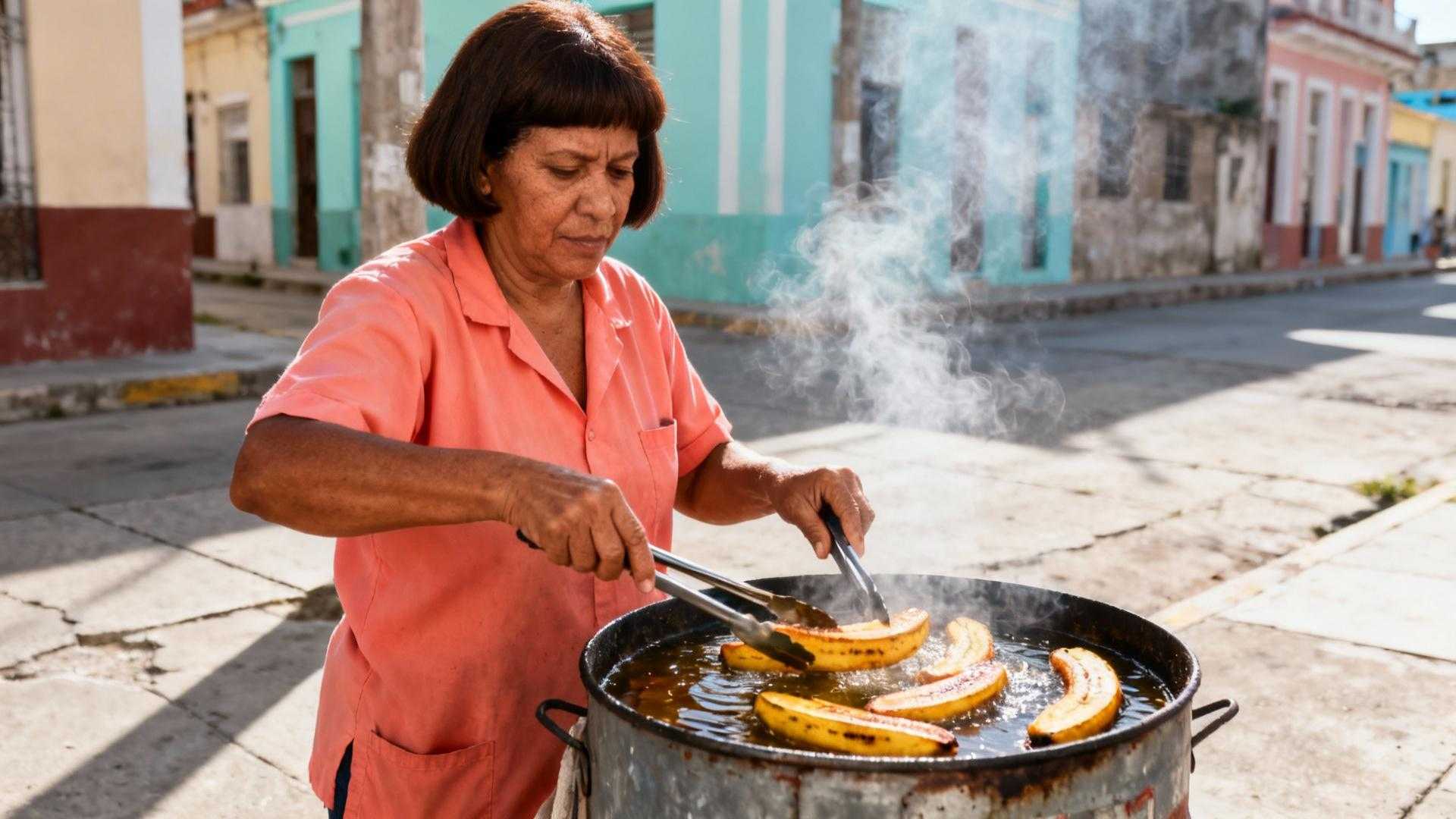Dawn breaks at Havana’s Cuatro Caminos market as vendors arrange yuca roots by size. Abuela Carmen arrives at 5:30am, clutching worn pesos while tourists sleep in Old Havana hotels. This parallel food universe exists where 11.2 million Cubans eat daily—not the licensed paladares charging $12 for ropa vieja, but neighborhood corners serving the same dish for three dollars. Here, meals follow memory rather than menus, and eating means joining rituals tourists never discover.
The 6am Ritual Tourists Sleep Through
Steam rises from coffee stands along Monte Street as fishermen’s wives fire up oil drums. The sound of plantains hitting hot grease echoes through residential blocks in Centro Havana. Morning vendors balance bread trays on heads, navigating cobblestones slick with Caribbean humidity.
Coffee roasters measure beans by eye, not scale, their hands mapping decades of ratios. This heritage preservation through daily practice defies tourist schedules. By 7am, working Cubans have consumed their $2 breakfast caldosa while hotel guests order $8 café con leche.
Dagmara Ruiz from Los Sitios neighborhood explains the pre-dawn reality. “We arrived at six in the morning although it was cold. People were already lining up for the butcher shop that appeared on television.”
What 11.2 Million Cubans Actually Cook at Home
Beyond paladar presentations lies authentic Cuban cooking rooted in scarcity wisdom. Home versions of ropa vieja simmer for hours using specific beef cuts locals prefer. Sofrito recipes passed through generations rely on exact proportions measured by memory, not restaurant specifications.
The Real Moros y Cristianos Philosophy
This rice and beans combination represents survival artistry, not tourist cuisine. Black beans and rice create complete proteins during lean months. The dish costs $3 at neighborhood stands versus $5 in licensed restaurants, using identical ingredients but grandmother’s techniques.
The Neighborhood Sofrito Secret
Authentic sofrito begins with garlic, onion, and bell peppers sautéed in limited oil. Home cooks add cumin and oregano in proportions learned from watching, never measuring. This grandmother-taught culinary knowledge surpasses formal cooking instruction.
Where Habaneros Eat When They’re Not Working
Residential Havana harbors food spots serving locals exclusively, invisible to tourist maps. Street corner vendors operate from 6am to 8am, selling caldosa soup for morning sustenance. Working Cubans rely on these $2 breakfast stands throughout Santos Suárez and Vedado’s residential blocks.
The Fisherman’s Wife Network
Cojímar’s waterfront features doorway vendors frying fresh catch in repurposed oil drums. Wives of fishermen operate on trust systems among regular customers. A plate of fried fish costs 55 pesos compared to $15 seafood dishes in tourist zones.
Payment operates through informal credit among neighbors who know each other’s work schedules. This protected local food culture maintains community bonds tourism cannot commercialize.
The Corner Tostones Stand
Plantain vendors select fruit by touch, knowing exact ripeness stages for perfect tostones. Green plantains get double-fried using techniques unchanged since Spanish colonial times. Each vendor guards their oil temperature secrets jealously.
The Taste That Defines Cuban Survival
Cuban food culture embodies resilience through the Special Period’s scarcity years. Coffee rituals survived when beans became luxury items, maintaining social connections despite economic hardship. Elena Gutierrez observes how “our history lives as much in our food as our words.”
Locally produced rum and hand-rolled tobacco represent cultural resistance against imported alternatives. Neighborhood tostaderos roast coffee beans in small batches, creating flavors commercial imports cannot replicate. This authentic village life persists despite tourism pressure.
Food connects families during celebrations, transcending kitchen boundaries to become gathering mediums. The communal nature of Cuban meals highlights who sits around tables, not just what’s served.
Your Questions About Cuban Food Culture Answered
Can tourists respectfully access neighborhood food spots?
Basic Spanish phrases and avoiding photography without permission opens doors to authentic experiences. Understanding Cuba’s informal economy helps visitors appreciate vendors earning 1,000 pesos monthly. Respecting residential areas and local customs allows genuine cultural exchange.
How does Cuban home cooking differ from paladar presentations?
Home versions use resource creativity developed during decades of scarcity. Specific yuca varieties and plantain ripeness stages create flavors tourists cannot easily access. Improvisation skills passed through generations produce authentic tastes restaurant standardization cannot capture.
How does Cuban street food compare to Caribbean neighbors?
Unlike Dominican Republic’s commercialized beach food or Puerto Rico’s regulated food trucks, Cuban street food maintains Spanish colonial influences. Economic constraints preserved traditional techniques tourism elsewhere has eroded, creating unique authentic experiences.
Morning steam rises from Abuela Carmen’s café colado at precisely 6:47am. Three spoonfuls of sugar, never measured, dissolve into darkness. Somewhere, tourists pay $8 for identical beans in restored colonial buildings, missing the morning ritual that defines taste.
